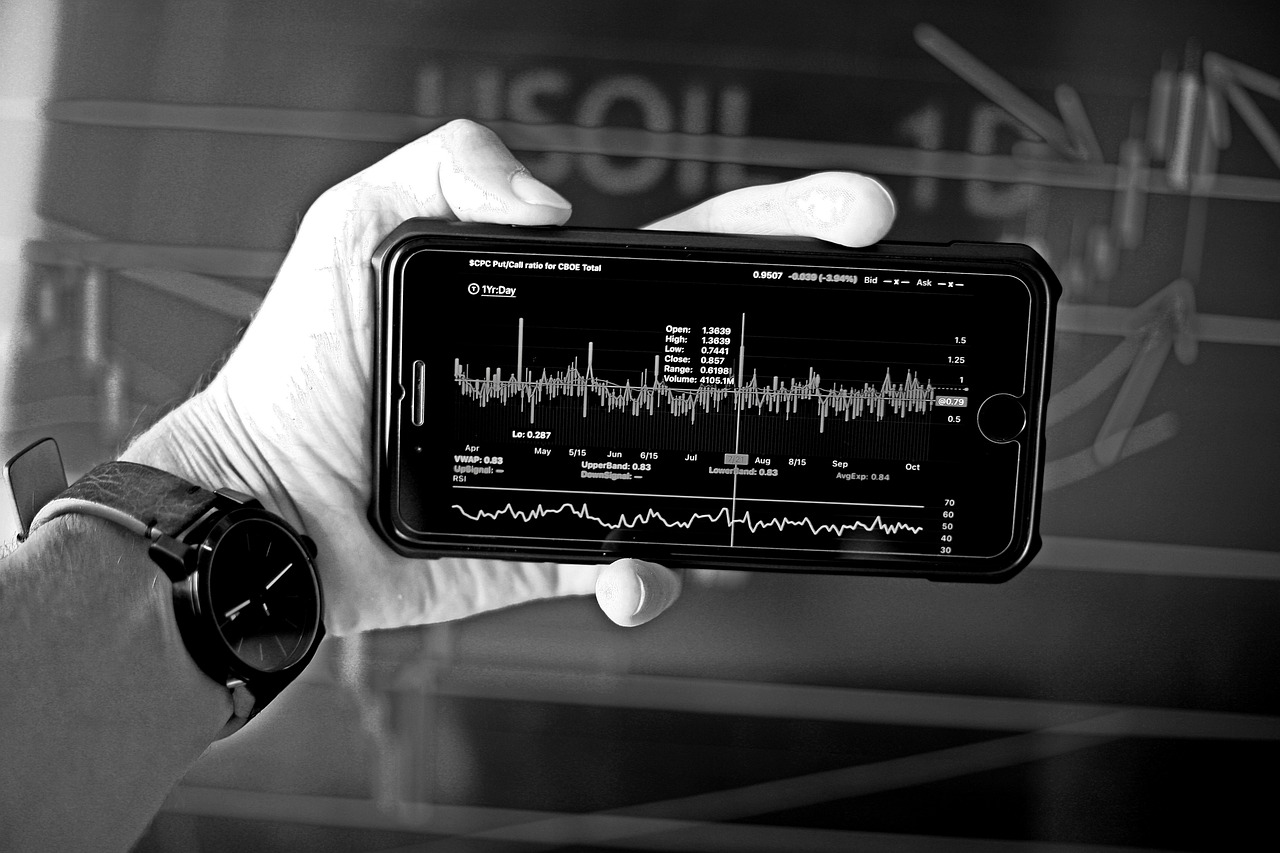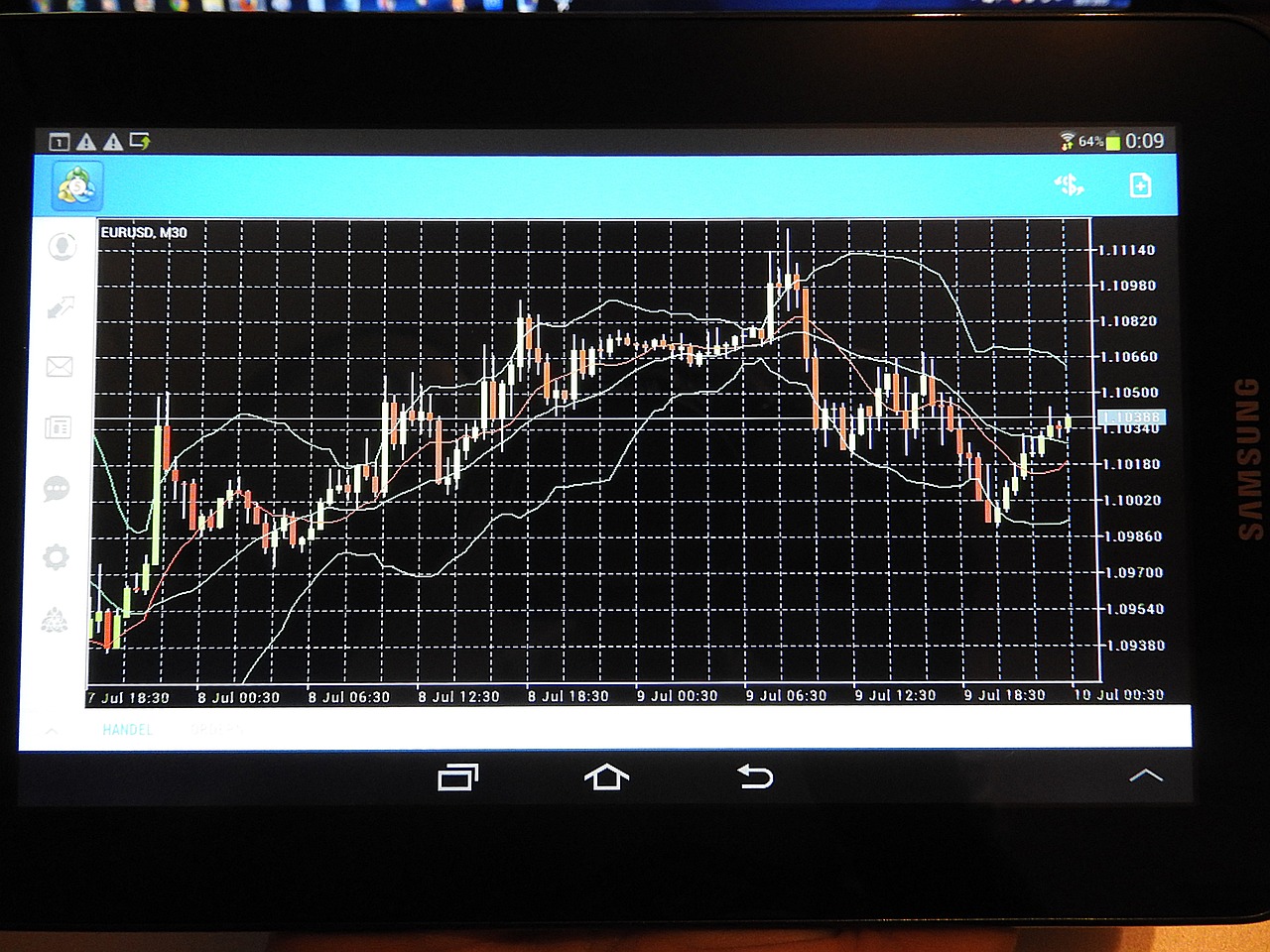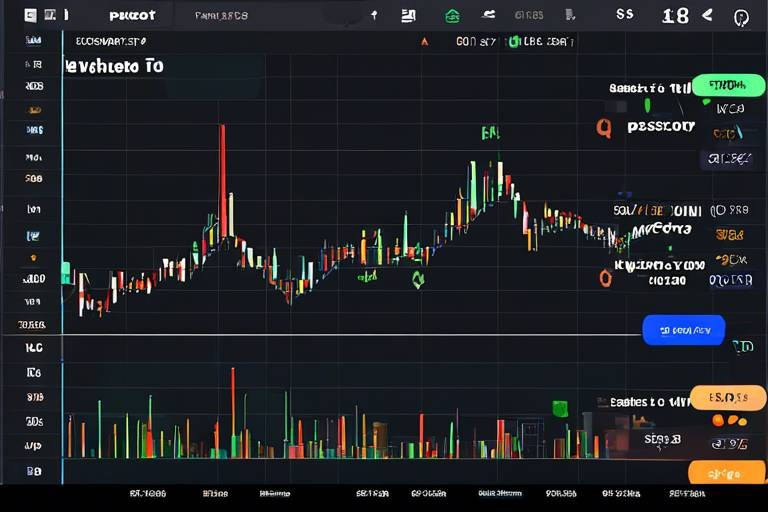How to Analyze Market Signals for Trading Success
In today's fast-paced financial landscape, the ability to analyze market signals is crucial for traders aiming for success. Whether you're a seasoned investor or just starting out, understanding these signals can make a world of difference in your trading strategy. Imagine navigating through a dense fog without a compass—market signals serve as that guiding light, illuminating the path to informed decisions. By effectively interpreting these signals, traders can enhance their performance and seize opportunities as they arise.
So, what exactly are market signals? In simple terms, they are indicators that help traders assess the current state of the market. Think of them as the heartbeat of the financial world, providing vital information about price movements, trends, and overall market sentiment. Market signals can be broadly categorized into three types: technical signals, fundamental signals, and sentiment signals. Each type plays a significant role in shaping trading strategies and decisions.
Understanding the different types of market signals is essential for any trader. They can be likened to the various instruments in a musician’s toolkit, each contributing to a harmonious trading strategy. Let's break down these types:
Technical signals are derived from price charts and indicators, providing insights based on historical price movements. They are the bread and butter of many traders, allowing them to identify trends and potential entry and exit points. Popular technical indicators include:
- Moving Averages
- Relative Strength Index (RSI)
- Bollinger Bands
Each of these indicators has its unique strengths and can inform trading decisions in different ways.
Moving averages are a powerful tool for smoothing out price data over a specific period, helping traders identify trends more clearly. By calculating the average price of an asset over a set number of days, traders can spot whether the market is trending upward or downward. For instance, a 50-day moving average can serve as a reliable indicator for long-term trends, while a 10-day moving average might be more useful for short-term trading strategies. The crossover of these averages can signal potential buy or sell opportunities, making them an essential part of any trader's arsenal.
The RSI is another critical technical indicator that measures the speed and change of price movements. Ranging from 0 to 100, the RSI helps traders identify whether an asset is overbought or oversold. A reading above 70 typically indicates that an asset is overbought, while a reading below 30 suggests it is oversold. Understanding these levels can provide traders with valuable insights into potential reversals in market trends.
While technical signals focus on price data, fundamental signals are rooted in economic data and news events. These signals can have a profound impact on market movements. For instance, economic indicators such as GDP growth, employment rates, and inflation can influence traders' perceptions of market health. Staying informed about major news events and economic reports is essential for analyzing fundamental signals effectively. By understanding the broader economic landscape, traders can make more informed decisions that align with market trends.
Sentiment analysis gauges the emotions and attitudes of market participants. It’s like reading the room at a party—understanding the mood can help you navigate social dynamics effectively. In trading, sentiment analysis can provide insights into market psychology, which can be just as important as technical and fundamental analysis. Tools such as social media trends and market surveys can be instrumental in assessing overall market sentiment.
Social media platforms are treasure troves of information when it comes to market sentiment. Traders can leverage these platforms to gauge public opinion on specific assets or market conditions. For example, a sudden surge in positive tweets about a particular stock could indicate growing investor interest, prompting traders to take action. Monitoring trends on platforms like Twitter and Reddit can provide valuable insights into market sentiment that traditional analysis might miss.
Market surveys offer quantitative data on trader sentiment, providing a snapshot of how market participants feel about current conditions. These surveys can help traders identify trends and potential reversals by analyzing the collective sentiment of market participants. Utilizing survey results can enhance trading decisions and strategies, allowing traders to align their actions with prevailing market sentiment.
Q1: What are market signals?
A1: Market signals are indicators that help traders assess market conditions, including price movements, trends, and overall sentiment.
Q2: How can I use technical signals in my trading strategy?
A2: Technical signals, such as moving averages and RSI, can help you identify trends and potential entry or exit points based on historical price data.
Q3: Why is sentiment analysis important?
A3: Sentiment analysis helps traders gauge the emotions and attitudes of market participants, providing insights into market psychology that can influence trading decisions.

Understanding Market Signals
Market signals are the lifeblood of trading, acting as indicators that help traders gauge the ever-changing landscape of financial markets. Think of them as the breadcrumbs that lead you to the treasure of informed decision-making. But what exactly are market signals? In simple terms, they are various metrics or indicators that reflect market conditions, guiding traders on when to buy or sell assets. Understanding these signals is crucial for anyone looking to navigate the turbulent waters of trading successfully.
There are several types of market signals, each serving a unique purpose in shaping trading strategies. They can be broadly categorized into three main types: technical signals, fundamental signals, and sentiment signals. Each type provides valuable insights that, when combined, create a comprehensive picture of market dynamics. For instance, technical signals often rely on historical price data and chart patterns, while fundamental signals focus on economic indicators and news events. Sentiment signals, on the other hand, delve into the emotions and attitudes of market participants, revealing potential market movements driven by psychology.
The significance of market signals cannot be overstated. They not only help in identifying trends but also in understanding the market's overall direction. By analyzing these signals, traders can make more informed decisions, reduce risks, and enhance their chances of success. Imagine trying to navigate through a dense fog without a compass; that's what trading without market signals feels like. Thus, mastering the art of analyzing market signals is essential for anyone aiming to thrive in the fast-paced world of trading.
In the following sections, we will explore the different types of market signals in greater detail, starting with technical signals, which are often the first tools traders reach for when analyzing market conditions. By understanding how to interpret these signals effectively, you can position yourself for better trading outcomes.

Types of Market Signals
When it comes to trading, understanding the is crucial for making informed decisions. Market signals can be broadly categorized into three main types: technical signals, fundamental signals, and sentiment signals. Each type serves a unique purpose and provides different insights into market behavior, ultimately shaping your trading strategy.
Technical signals are derived from price movements and chart patterns. They often involve the use of various indicators that help traders identify trends, reversals, and entry or exit points. For instance, moving averages and the Relative Strength Index (RSI) are popular tools that traders rely on. By analyzing these signals, traders can gauge whether a market is trending upwards or downwards, thus making more strategic decisions.
On the other hand, fundamental signals are rooted in economic data and news events. These signals reflect the underlying health of an economy and can significantly impact market movements. For example, employment reports, interest rate changes, and GDP growth figures are all fundamental indicators that traders closely monitor. Understanding these signals allows traders to anticipate market shifts based on economic conditions rather than just price movements.
Lastly, we have sentiment signals, which gauge the emotions and attitudes of market participants. Sentiment analysis can provide valuable insights into whether traders are feeling bullish or bearish about a particular asset. This type of analysis often involves examining social media trends, market surveys, and news sentiment. By understanding the prevailing market sentiment, traders can align their strategies with the collective mood of the market, potentially increasing their chances of success.
In summary, each type of market signal—technical, fundamental, and sentiment—plays a vital role in the trading landscape. By combining insights from all three, traders can develop a more comprehensive understanding of market dynamics, leading to more effective trading strategies. Remember, the key to successful trading lies in the ability to analyze and interpret these signals accurately.
- What are market signals? Market signals are indicators that help traders assess market conditions and make informed decisions.
- How do technical signals differ from fundamental signals? Technical signals are based on price movements and chart patterns, while fundamental signals are based on economic data and news events.
- Why is sentiment analysis important? Sentiment analysis helps traders gauge market participants' emotions, which can influence market movements.
- Can I use multiple types of signals in my trading strategy? Absolutely! Combining technical, fundamental, and sentiment signals can provide a more comprehensive view of the market.

Technical Signals
When it comes to trading, are like the compass guiding a sailor through turbulent seas. These signals are derived from price charts and various indicators, helping traders to make sense of the often chaotic movements in financial markets. They provide insights into potential price movements, enabling traders to identify opportunities and manage risks effectively. But what exactly are these indicators, and how can they be leveraged for trading success?
One of the most popular technical indicators is the Moving Average. Think of it as a smoothing agent for price data. By averaging the prices over a specific period, moving averages help traders identify the direction of the trend—whether it’s upward, downward, or sideways. This can be particularly useful in volatile markets where price fluctuations can be misleading. For instance, a 50-day moving average can help you determine the overall trend while filtering out the noise of daily price movements.
Another crucial technical signal is the Relative Strength Index (RSI). This powerful tool measures the speed and change of price movements, providing insights into whether an asset is overbought or oversold. The RSI ranges from 0 to 100, with readings above 70 typically indicating that an asset is overbought and may be due for a correction, while readings below 30 suggest that it is oversold and could rebound. Understanding how to interpret RSI readings can significantly enhance your trading strategies, allowing you to make informed decisions based on market momentum.
To illustrate the effectiveness of these technical signals, let's take a closer look at a simple trading strategy that incorporates both moving averages and RSI. Imagine you’re analyzing a stock that has been trending upward. If the stock's price crosses above the 50-day moving average and the RSI is below 30, this could signal a buying opportunity. Conversely, if the price drops below the moving average and the RSI exceeds 70, it might be time to consider selling. This combination of signals can help you navigate the complexities of trading with greater confidence.
In conclusion, technical signals are invaluable tools in a trader's arsenal. By understanding how to read and interpret these indicators, you can enhance your trading strategies and make more informed decisions. Remember, the key is not to rely solely on one signal but to use a combination of indicators to gain a comprehensive view of the market. As you become more familiar with these tools, you’ll find that your ability to predict market movements will improve, leading to greater trading success.

Moving Averages
Moving averages are like the calm in the storm of market volatility. They help traders identify the underlying trend by smoothing out price fluctuations over a specific period. Imagine trying to read a book while someone is flipping the pages rapidly; it’s tough to focus on the story. Now, think of moving averages as the steady hand that holds the book still, allowing you to grasp the plot much easier. By calculating the average price over a set number of periods, moving averages provide a clearer picture of where the market might be heading.
There are two primary types of moving averages that traders often use: the Simple Moving Average (SMA) and the Exponential Moving Average (EMA). The SMA is calculated by adding the closing prices over a specified number of periods and dividing by that number. For example, a 10-day SMA takes the closing prices of the last 10 days, adds them up, and divides by 10. On the other hand, the EMA gives more weight to the most recent prices, making it more responsive to new information. This responsiveness can be crucial when making quick trading decisions.
To illustrate how moving averages can be applied in trading strategies, consider the following table:
| Type of Moving Average | Calculation Method | Best Used For |
|---|---|---|
| Simple Moving Average (SMA) | Average of closing prices over a set period | Identifying long-term trends |
| Exponential Moving Average (EMA) | Weighted average that gives more importance to recent prices | Short-term trading signals |
When employing moving averages in your trading strategy, one common technique is to look for crossovers. A crossover occurs when a shorter-term moving average crosses above or below a longer-term moving average. For instance, if the 50-day EMA crosses above the 200-day EMA, it might signal a potential uptrend, often referred to as a "golden cross." Conversely, if the 50-day EMA crosses below the 200-day EMA, it could indicate a potential downtrend, known as a "death cross." These signals can serve as powerful indicators for entering or exiting trades.
However, it’s essential to remember that moving averages are lagging indicators; they react to price movements rather than predict them. Therefore, while they can provide valuable insights, they should be used in conjunction with other indicators and analysis methods to enhance their effectiveness. Think of moving averages as part of a larger toolkit that includes technical signals, fundamental analysis, and sentiment analysis. By combining these elements, traders can create a more robust strategy that adapts to changing market conditions.
In summary, moving averages are a fundamental tool in a trader's arsenal. They simplify the complexity of price movements and help traders make informed decisions. Whether you're a novice trying to navigate the waters of trading or a seasoned trader refining your strategy, understanding how to effectively use moving averages can be a game-changer in your trading journey.
- What is the main purpose of moving averages in trading? Moving averages help traders identify trends and smooth out price fluctuations, making it easier to make informed trading decisions.
- How do I choose the right period for a moving average? The choice of period depends on your trading strategy; shorter periods (like 10 or 20 days) are better for short-term trading, while longer periods (like 50 or 200 days) are suited for long-term trends.
- Can moving averages be used for all markets? Yes, moving averages can be applied across various financial markets, including stocks, forex, and commodities.

Relative Strength Index (RSI)
The is one of the most popular momentum indicators used in technical analysis. Developed by J. Welles Wilder Jr. in the late 1970s, the RSI provides traders with valuable insights into the strength and speed of price movements. But what exactly does it measure? Essentially, the RSI quantifies the speed at which a security's price changes, allowing traders to assess whether an asset is overbought or oversold. This is crucial because, in the world of trading, timing is everything!
The RSI is calculated using a simple formula that compares the average gains and losses over a specified period, typically 14 days. The result is a value that ranges from 0 to 100. Generally, an RSI above 70 indicates that a security is becoming overbought, while an RSI below 30 suggests it is oversold. However, these thresholds are not set in stone; savvy traders often adjust them based on market conditions and specific trading strategies.
To give you a clearer picture, let’s take a look at how the RSI might appear in a trading scenario:
| RSI Value | Market Condition | Trading Action |
|---|---|---|
| 0 - 30 | Oversold | Consider buying |
| 30 - 70 | Neutral | Hold or wait |
| 70 - 100 | Overbought | Consider selling |
But how do you actually interpret these readings in real-life trading? Well, it’s not just about looking at the number; it’s about understanding the context. For instance, if the RSI indicates that a stock is overbought, it doesn’t automatically mean you should sell. You need to consider other factors such as market trends, news events, and even other technical indicators. Think of the RSI as a piece of a larger puzzle; it’s essential, but it’s not the only piece that matters.
Moreover, the RSI can also generate divergences, which can be powerful signals. For example, if the price of a stock reaches a new high but the RSI fails to do so, this divergence might suggest a potential reversal. In such cases, traders often prepare for a shift in market momentum. This is where the RSI shines as a tool for not just confirming trends but also spotting potential trend reversals.
In summary, the Relative Strength Index is a dynamic tool that can enhance your trading strategy. By understanding how to read the RSI and incorporating it with other market signals, you can make more informed trading decisions. So, the next time you're analyzing a stock, remember to check the RSI—it might just give you the edge you need!
- What is the best RSI setting for trading? While the default setting is typically 14 days, some traders prefer to adjust this based on their trading style. Shorter periods can provide more signals, while longer periods may filter out noise.
- Can the RSI be used for all asset classes? Absolutely! The RSI can be applied to stocks, forex, commodities, and cryptocurrencies. However, the interpretation may vary slightly depending on the asset's volatility.
- Is the RSI a standalone indicator? No, it's best used in conjunction with other indicators and analysis methods to improve accuracy and minimize false signals.

Fundamental Signals
When it comes to trading, understanding is like having a secret map that guides you through the often turbulent waters of financial markets. These signals are derived from economic data, news events, and various indicators that reflect the health of an economy. Imagine you're trying to navigate a vast ocean; knowing the weather patterns, tides, and currents can be the difference between reaching your destination or getting lost at sea. In the trading world, these fundamental signals serve a similar purpose, providing insights that can shape your trading decisions and strategies.
Fundamental signals can be categorized into several key areas, each contributing to a trader's understanding of market dynamics. For instance, economic indicators such as Gross Domestic Product (GDP), employment rates, and inflation data are crucial. These figures help you gauge the overall economic health of a country, which directly influences the strength of its currency and the performance of its stock market. When GDP is soaring, it often signals a robust economy, leading to increased investor confidence and potentially higher asset prices. On the flip side, a decline in GDP can send ripples of uncertainty through the market, prompting traders to reconsider their strategies.
Moreover, news events play a pivotal role in shaping market sentiment. For instance, announcements from central banks regarding interest rate changes can create significant volatility. Traders must stay updated on these announcements, as they can lead to sharp price movements. Think of it like a surprise storm that can change a clear day into a chaotic downpour. By staying informed about economic calendars and key events, traders can better anticipate market reactions and align their strategies accordingly.
Another important aspect of fundamental signals is the interpretation of earnings reports from publicly traded companies. These reports provide insights into a company's performance and future prospects. A strong earnings report can boost a company's stock price, while a disappointing one can lead to a sharp decline. Traders should analyze these reports not just for the numbers but also for the narrative behind them. Are there any underlying trends or challenges that could impact future performance? This level of analysis can help traders make informed decisions rather than relying solely on gut feelings.
To further illustrate the importance of fundamental signals, consider the following table that outlines some key economic indicators and their potential impact on market sentiment:
| Economic Indicator | Impact on Market |
|---|---|
| Gross Domestic Product (GDP) | High GDP growth can boost investor confidence; low growth may lead to market sell-offs. |
| Employment Rates | Increasing employment rates generally indicate economic strength, while rising unemployment can signal trouble. |
| Inflation Rates | High inflation can erode purchasing power and lead to central bank interventions, affecting market stability. |
| Central Bank Interest Rate Announcements | Rate hikes can strengthen a currency, while cuts can weaken it, impacting trading strategies. |
In conclusion, fundamental signals provide a comprehensive view of the market landscape. By keeping an eye on economic indicators, news events, and corporate earnings, traders can enhance their decision-making process and improve their chances of success. It's essential to remember that while technical analysis focuses on price movements, fundamental analysis digs deeper into the underlying factors that drive those movements. Combining both approaches creates a well-rounded trading strategy that can adapt to ever-changing market conditions.
- What are fundamental signals in trading?
Fundamental signals are indicators derived from economic data and news events that help traders assess market conditions and make informed decisions. - How do economic indicators affect trading?
Economic indicators provide insights into the health of an economy, influencing investor sentiment and market movements. For example, a strong GDP report can lead to increased buying activity in the markets. - Why is it important to analyze earnings reports?
Earnings reports reveal a company's financial performance and future prospects, allowing traders to make informed decisions about buying or selling stocks based on the company's outlook. - How can I stay updated on fundamental signals?
Traders can stay informed by following economic calendars, subscribing to financial news outlets, and using market analysis tools that provide real-time updates on key economic events.

Sentiment Analysis
In the fast-paced world of trading, understanding market sentiment can be the key to unlocking profitable opportunities. But what exactly is sentiment analysis? In simple terms, it’s the process of gauging the emotions and attitudes of market participants, which can often drive price movements just as much as fundamental data or technical indicators. Think of it like reading the mood of a crowd at a concert; if the crowd is energetic and excited, you can expect a lively performance, while a subdued crowd might lead to a lackluster show. Similarly, a bullish sentiment can propel prices higher, while bearish sentiment can drag them down.
To effectively analyze sentiment, traders often turn to a variety of tools and techniques. One of the most popular methods is monitoring social media trends. Platforms like Twitter, Reddit, and Facebook are buzzing with opinions and discussions that can provide invaluable insights into how traders feel about certain stocks or the market as a whole. For instance, if you notice a surge in positive tweets about a particular company, it might be a sign that traders are feeling optimistic, which could lead to upward price movement. On the flip side, a wave of negative sentiment can trigger sell-offs.
Another powerful tool for sentiment analysis is market surveys. These surveys gather quantitative data from traders regarding their expectations and feelings about the market. By analyzing survey results, traders can better understand the prevailing sentiment and adjust their strategies accordingly. For example, if a survey reveals that a significant percentage of traders are feeling bearish about the market, it might be wise to adopt a more cautious approach. Conversely, if sentiment is overwhelmingly bullish, it could be an opportune moment to capitalize on potential gains.
| Sentiment Analysis Tools | Description |
|---|---|
| Social Media Monitoring | Analyzing posts and comments on platforms like Twitter and Reddit to gauge public sentiment. |
| Market Surveys | Collecting data from traders about their expectations and feelings toward the market. |
| News Sentiment Analysis | Evaluating news headlines and articles to determine how they may influence market sentiment. |
Ultimately, sentiment analysis is about connecting the dots. It’s not just about what the numbers say; it’s about understanding the human element behind those numbers. Traders who can effectively analyze sentiment can make more informed decisions, potentially leading to greater success in their trading endeavors. So, the next time you’re considering a trade, take a moment to reflect on the broader sentiment in the market. Are people feeling optimistic or pessimistic? This insight could be the difference between a winning trade and a costly mistake.
- What is sentiment analysis in trading? Sentiment analysis in trading refers to the evaluation of market participants' emotions and attitudes, which can influence price movements.
- How can social media impact market sentiment? Social media can provide real-time insights into trader opinions, allowing traders to gauge market sentiment based on public discussions and trends.
- What role do market surveys play in sentiment analysis? Market surveys collect quantitative data on trader sentiment, helping traders understand prevailing attitudes and adjust their strategies accordingly.

Social Media Trends
In today's fast-paced trading environment, have emerged as a powerful tool for traders looking to gauge market sentiment. With platforms like Twitter, Facebook, and Reddit buzzing with discussions about stocks, commodities, and cryptocurrencies, it's crucial to tap into this wealth of information. Think of social media as a vast ocean of opinions and emotions; by diving in, traders can uncover hidden signals that might influence market movements.
So, how can you effectively leverage social media for your trading strategies? First off, it's essential to identify the right platforms. While Twitter is known for its real-time updates, Reddit offers in-depth discussions through forums like WallStreetBets, where traders share insights and predictions. By following influential traders and analysts on these platforms, you can gain valuable perspectives that may not be available through traditional news sources.
Another key aspect is to pay attention to trending hashtags and topics. For instance, if a particular stock is trending on Twitter with a specific hashtag, it often indicates a surge in interest or speculation around that stock. This can serve as a market signal that warrants further investigation. However, it's crucial to approach this information with a discerning eye; not every trend will lead to profitable trades. Always consider the context and verify the information before making any trading decisions.
Moreover, sentiment analysis tools can help you quantify social media trends. These tools analyze the volume and tone of posts related to specific assets, providing insights into whether the overall sentiment is bullish or bearish. For example, a sudden spike in positive tweets about a company might suggest a buying opportunity, while a flood of negative comments could indicate potential risks. Here's a simple table to illustrate how sentiment can influence trading decisions:
| Sentiment | Market Action | Potential Outcome |
|---|---|---|
| Positive | Buy | Price Increase |
| Negative | Sell | Price Decrease |
| Neutral | Hold | Stability |
Ultimately, while social media trends can provide valuable insights, they should be used in conjunction with other analysis methods. It's like having a toolbox; social media is one of the tools that can help you build a more comprehensive trading strategy. By combining social sentiment with technical and fundamental analysis, you can create a well-rounded approach that enhances your chances of success in the ever-evolving financial markets.
- How can social media affect stock prices? Social media can influence stock prices by shaping public perception and sentiment, leading to increased buying or selling activity.
- What tools can I use to analyze social media trends? There are various sentiment analysis tools available, such as Hootsuite, Brandwatch, and Sprout Social, which can help you track and analyze social media discussions.
- Is it safe to rely on social media for trading decisions? While social media can provide valuable insights, it’s essential to corroborate information with other sources and perform thorough analysis before making trading decisions.

Market Surveys
Market surveys are a powerful tool for traders looking to gauge the sentiment and expectations of their peers in the financial markets. By collecting quantitative data on trader sentiment, these surveys provide invaluable insights that can inform your trading strategies. Imagine walking into a bustling marketplace, where every vendor is shouting about their goods; that's akin to listening to the market's pulse through surveys. They allow you to tap into the collective consciousness of market participants, revealing whether they are feeling bullish, bearish, or somewhere in between.
One of the key benefits of market surveys is their ability to highlight trends that may not be immediately apparent through price action alone. For instance, if a survey indicates that a significant percentage of traders expect a price increase in a particular asset, it could signal a potential buying opportunity. Conversely, if the majority are anticipating a downturn, it might be wise to reconsider your position. This is where understanding the importance of timing comes into play; acting on survey results can sometimes be the difference between profit and loss.
To effectively utilize market surveys, traders should consider the following aspects:
- Source of the Survey: Ensure that the survey is conducted by a reputable organization or platform. Surveys from credible sources tend to yield more reliable results.
- Sample Size: The larger the sample size, the more representative the results will be. A survey with only a handful of respondents may not accurately reflect market sentiment.
- Frequency: Regularly updated surveys can provide ongoing insights into shifting market dynamics, making them a valuable resource for day traders and long-term investors alike.
Incorporating survey results into your trading strategy requires a nuanced approach. It's not just about following the crowd; it's about understanding the underlying reasons behind the sentiment. For example, if a survey shows that traders are overwhelmingly bullish on a stock, dig deeper. What news or events are driving this sentiment? Is it based on solid fundamentals or mere speculation? This critical analysis will help you make more informed decisions.
To illustrate the impact of market surveys, consider the following hypothetical example:
| Survey Date | Asset | Trader Sentiment (%) | Price Movement (Next Week) |
|---|---|---|---|
| 01/01/2023 | XYZ Corp | 70% Bullish | +5% |
| 01/08/2023 | XYZ Corp | 30% Bullish | -3% |
| 01/15/2023 | XYZ Corp | 50% Bullish | +2% |
This table highlights how trader sentiment can influence price movements. After a bullish sentiment of 70%, the asset experienced a price increase, while a subsequent drop in bullish sentiment correlated with a price decline. By analyzing these results, traders can better position themselves to capitalize on market trends.
In conclusion, market surveys are not just numbers; they are a reflection of the collective mindset of traders. By understanding and analyzing these surveys, you can enhance your trading strategies and make more informed decisions. Remember, the market is often driven by emotions, and tapping into those emotions through surveys can provide you with a significant edge in your trading endeavors.
Q: How often should I check market surveys?
A: It depends on your trading style. Day traders may check them daily, while long-term investors might look at them weekly or monthly.
Q: Can market surveys guarantee success in trading?
A: No, while they provide valuable insights, they should be used in conjunction with other analysis methods.
Q: Where can I find reliable market surveys?
A: Look for surveys published by reputable financial news organizations or trading platforms.
Frequently Asked Questions
- What are market signals?
Market signals are indicators that help traders assess the current market conditions. They provide insights into potential price movements and trends, enabling traders to make informed decisions.
- What types of market signals should I consider?
There are three primary types of market signals: technical signals, fundamental signals, and sentiment signals. Each type offers unique insights that can influence trading strategies.
- How do technical signals work?
Technical signals are derived from price charts and various indicators. They help traders identify trends, entry and exit points, and potential price reversals based on historical price movements.
- What is a moving average, and how is it used?
A moving average is a technical indicator that smooths out price data to identify trends over a specific period. Traders use moving averages to determine whether to buy or sell based on the direction of the trend.
- Can you explain the Relative Strength Index (RSI)?
The RSI is a momentum oscillator that measures the speed and change of price movements. It ranges from 0 to 100 and is typically used to identify overbought or oversold conditions in a market.
- What role do fundamental signals play in trading?
Fundamental signals are based on economic data and news events that can impact market movements. Traders analyze these signals to understand the underlying factors driving price changes and to make informed trading decisions.
- How can I assess market sentiment?
Market sentiment can be gauged through various tools and techniques, including social media analysis and market surveys. Understanding sentiment helps traders anticipate potential market movements based on the collective emotions of market participants.
- What is the importance of social media trends in trading?
Social media platforms can provide real-time insights into market sentiment. By analyzing trends and discussions on these platforms, traders can gauge public opinion and adjust their strategies accordingly.
- How do market surveys enhance trading decisions?
Market surveys provide quantitative data on trader sentiment, offering insights into how traders feel about current market conditions. This information can help traders make more informed decisions based on the prevailing sentiment.



















